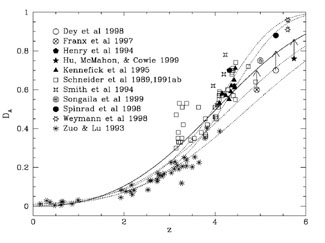


7.3. Effects of the IGM: Hints of the Gunn-Peterson Effect?
The ability of astronomers to calculate reliable photometric redshifts
at z > 3 is largely due to the neutral hydrogen absorption in
the intergalactic medium (IGM). Absorption below the redshifted Lyman
limit,
Ly , and
Ly
, and
Ly strongly modulates
the observed optical spectra of the objects we are interested in. At
sufficiently high redshifts, the continuum depression blueward of
Ly
strongly modulates
the observed optical spectra of the objects we are interested in. At
sufficiently high redshifts, the continuum depression blueward of
Ly (the
Ly
(the
Ly forest) dominates
over those decrements associated with higher members of the Lyman
series.
Oke & Koryanski (1982)
define the DA parameter to measure the strength
of the Ly
forest) dominates
over those decrements associated with higher members of the Lyman
series.
Oke & Koryanski (1982)
define the DA parameter to measure the strength
of the Ly decrement
decrement
 |
(3) |
(see Fig. 12). The "predicted" denominator in
equation (3) is the extrapolated continuum observed
at longer wavelengths carried to the

 1050-1170 region. The
question is: at what redshift does the
Ly
1050-1170 region. The
question is: at what redshift does the
Ly forest become an
impenetrable "jungle"?
forest become an
impenetrable "jungle"?
 |
Figure 12. Values of the continuum
depression blueward of
Ly |
This is an intriguing question, as we are now observing galaxies at
early enough cosmic epoch that we may perhaps encounter the edge of the
"Dark Era" - prior to the complete reionization of the IGM when the
universe is still optically thick below the rest wavelength of
Ly . Theoretical
estimates suggest that the dark era ends between z = 5 and
z = 20
(Shapiro 1995;
Rees 1995;
Miralda-Escude & Rees
1997;
Madau et al. 1998).
Observationally, we would expect a (Gunn-Peterson) trough of complete
absorption for some interval shortward of Ly
. Theoretical
estimates suggest that the dark era ends between z = 5 and
z = 20
(Shapiro 1995;
Rees 1995;
Miralda-Escude & Rees
1997;
Madau et al. 1998).
Observationally, we would expect a (Gunn-Peterson) trough of complete
absorption for some interval shortward of Ly , corresponding to the epoch
when the universe was completely opaque to
Ly
, corresponding to the epoch
when the universe was completely opaque to
Ly photons.
photons.
How can we measure the Gunn-Peterson effect? For objects of I ~
26, the obvious problem is one of signal-to-noise ratio. Combining the
results of our spectrophotometry with deep HST images, we measure
rather large values of DA for HDF 3-951.0 (z =
5.34; DA = 0.88;
Dey et al. 1998)
and HDF 4-473.0 (z = 5.60; DA =
0.91-0.96;
Weymann et al. 1998).
Our concern about the break amplitude arises from its strength: the
Madau (1995)
theoretical estimate of the contribution of the
Ly forest to
DA (solid line in Fig. 12) is
only
forest to
DA (solid line in Fig. 12) is
only  0.79 at z
= 5.34 and
0.79 at z
= 5.34 and
 0.83 at z =
5.60. This extrapolation assumes a distribution of high and low optical
depth foreground
Ly
0.83 at z =
5.60. This extrapolation assumes a distribution of high and low optical
depth foreground
Ly clouds causing Lyman
series absorption in the spectrum of a distant quasar or galaxy. The
dotted lines in Figure 12 represent different
models of DA from
Zhang et al. (1997).
Using the data of
Steidel & Sargent
(1987)
and Zuo & Lu (1993),
they estimate the mean intergalactic
Ly
clouds causing Lyman
series absorption in the spectrum of a distant quasar or galaxy. The
dotted lines in Figure 12 represent different
models of DA from
Zhang et al. (1997).
Using the data of
Steidel & Sargent
(1987)
and Zuo & Lu (1993),
they estimate the mean intergalactic
Ly opacity
opacity

 as a function of
redshift using two parameterizations of
as a function of
redshift using two parameterizations of

 :
:

 = A(1 +
z)3.46 and
= A(1 +
z)3.46 and

 =
Ae
=
Ae (1+z). The scatter around the theoretical
curves is substantial, even at lower redshifts, so the high values of
DA at z > 5 may simply reflect the usual
scatter observed in that parameter. However, the possibility to directly
measure the epoch of reionization is not to be overlooked. The best
chance for this will be with the discovery of a bright(er) object at
z > 5, either in the form of a quasar, or a magnified galaxy
behind a rich galaxy cluster.
(1+z). The scatter around the theoretical
curves is substantial, even at lower redshifts, so the high values of
DA at z > 5 may simply reflect the usual
scatter observed in that parameter. However, the possibility to directly
measure the epoch of reionization is not to be overlooked. The best
chance for this will be with the discovery of a bright(er) object at
z > 5, either in the form of a quasar, or a magnified galaxy
behind a rich galaxy cluster.